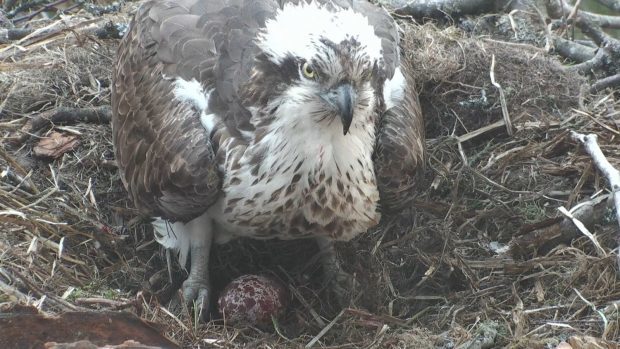It isn’t Easter yet, but the first egg of the season was laid this week at the Loch of the Lowes Wildlife Reserve by female osprey Lassie.
It equalled the earliest recorded lay, which was previously set on April 4 in 2005.
Scottish Wildlife Trust ranger, Charlotte Fleming, had been waiting anxiously for Lassie and her mate Laddie to deliver good news before she herself flies off to a new position in the north-west Highlands.
The raptors have been scrutinised around the clock after they returned to the site towards the end of March for Lassie’s third season.
She didn’t disappoint and stood up at 7.10pm on Tuesday to reveal a mottled brown egg on the nest at the reserve.
Ms Fleming, Perthshire Ranger at the Scottish Wildlife Trust said: “She gave us a first glimpse of the egg just after 7pm on Tuesday, then Laddie swooped in to investigate shortly afterwards.
“After a brief squabble to decide who would incubate the egg, the female settled down for the night.
“We would expect the egg to hatch in about six weeks’ time.
“It’s now clear that the pair’s attempts at breeding have been a success and they are on track to repeat the hat-trick of chicks that were hatched in both 2015 and 2016.”
The pair are the only mating ospreys currently at Loch of the Lowes, where another female raptor, Lady, had previously been a regular – and fecund – visitor.
The latter has not returned to the reserve since 2014, but laid a record-breaking 71 eggs and fledged 50 chicks in her lifetime.
Thanks to participants in the People’s Postcode Lottery, the Osprey Protection team are watching the nest 24 hours a day to monitor their progress and also prevent human disturbance.
Clara Govier, head of charities at the lottery, said: “Our players will be delighted that Lassie has laid her first egg of the season and our fingers are crossed for another successful year for the ospreys at Loch of the Lowes Wildlife Reserve.”
Osprey eggs are around the size of a duck egg and are laid just one or two days apart. This means a full clutch of three could be delivered by the start of next week.
Since reuniting on Thursday March 23, the birds have been defending their nest from intruding male ospreys and bringing in fish from the nearby lochs.
